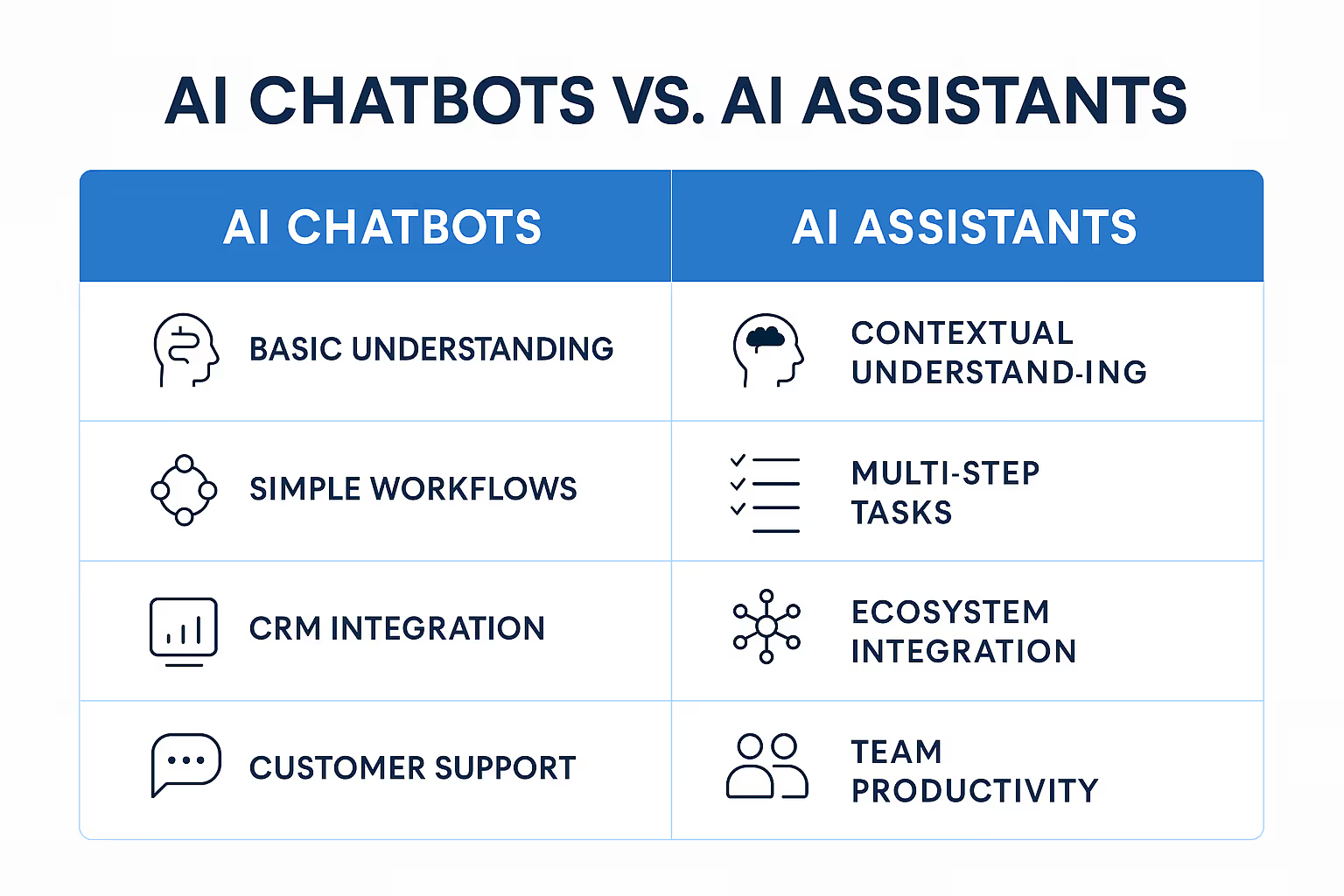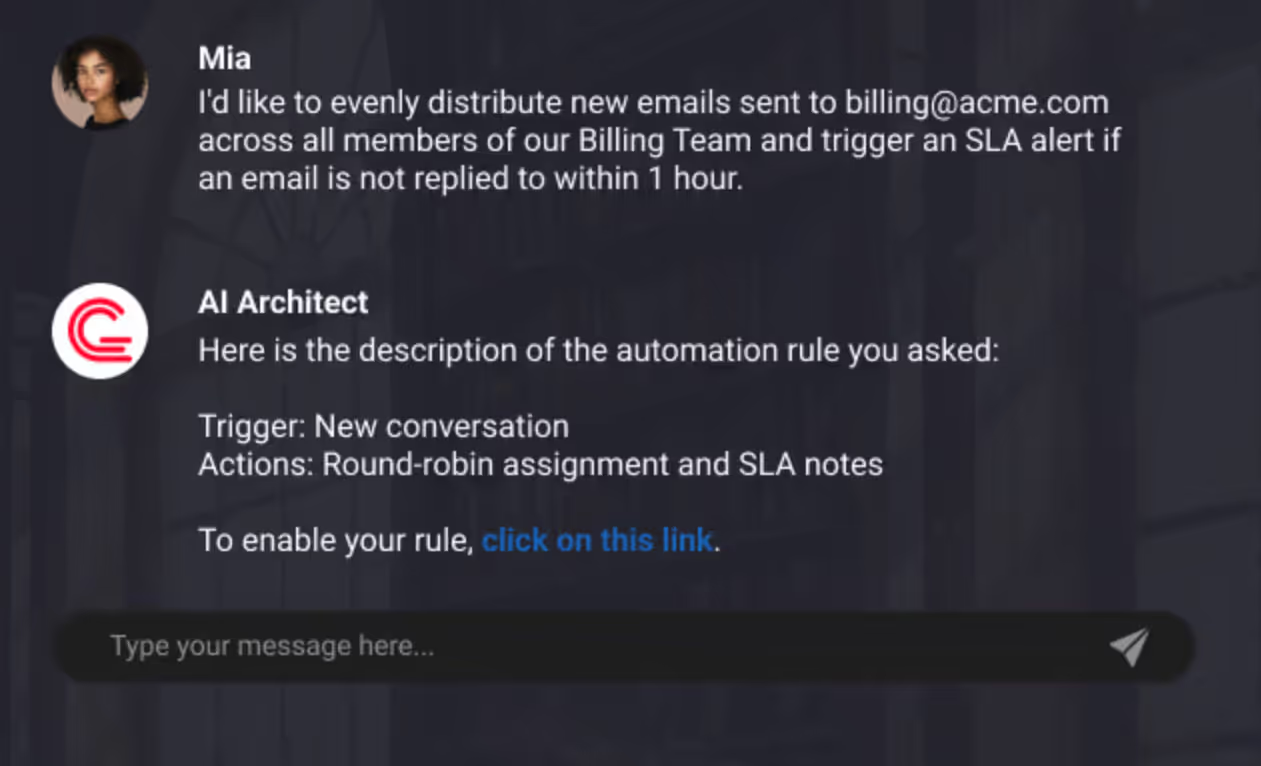Choosing the right AI tools for your business starts with understanding what each one actually does. With new capabilities, comes new terminology. AI assistants and AI chatbots may sound interchangeable, but they solve different problems, offer distinct functionalities, and are built for different kinds of interactions.
Knowing the difference is key to choosing the best solution for your organization. In this blog, we’ll break down how each tool works, their core use cases, and how to decide which is best suited to your needs.
What Is an AI Assistant?
An AI assistant is a digital tool designed to automate tasks, manage workflows, and support decision-making through contextual understanding. It acts as an intelligent helper, often embedded directly into the tools you already use (like Gmail or Microsoft Office), to streamline processes and boost productivity.
Learn more in our post on how AI assistants help businesses.
Common features and capabilities
AI assistants have various characteristics, among which we can find:
- Task automation: AI assistants handle repetitive tasks such as sorting emails, drafting responses, or assigning team responsibilities.
- Contextual understanding: They analyze the context of a message or conversation to generate accurate and relevant outputs.
- Multi-step workflows: AI assistants can handle complex sequences of actions, such as escalating issues or updating multiple systems based on a single interaction.
Top tools
Here are three of the leading AI assistants making a real impact across different use cases:
- Gmelius AI: A Gmail-native assistant that automates email replies, templates, and workflows for teams.
- Google Assistant: A personal productivity tool that helps with scheduling, reminders, and voice-based queries.
- Microsoft Copilot: Integrated into Office tools to assist with writing, data analysis, and content creation.
What Is an AI Chatbot?
AI chatbots are designed primarily for specific, task-oriented conversations, often using predefined scripts or simple AI, embedded on websites or messaging platforms. Their main role is to engage users in real-time conversations, often answering FAQs or routing queries to human agents.
Common features
Some of the core capabilities that make define how chatbots operate:
- Rule-based or NLP-driven responses: Chatbots operate using either predefined scripts or more advanced natural language processing.
- Live chat routing: They can hand over complex queries to human support teams when needed.
- FAQ handling: Chatbots excel at handling repetitive, simple queries instantly.
Top tools
Here are some of the best tools available in the market.
- Intercom Fin: Offers multilingual support, deflection, and contextual FAQ suggestions.
- Drift: A chatbot focused on sales conversations and lead qualification.
- Zendesk bots: Integrated with Zendesk's customer service tools to assist with basic support tasks.
Key Differences Between AI Assistants and Chatbots

While both AI assistants and chatbots rely on artificial intelligence to streamline communication, their roles, capabilities, and technical implementations are quite different. Below are the five core distinctions that set them apart:
1. Depth of understanding
AI assistants are built to grasp context and nuance. They analyze ongoing conversations, user behavior, and past interactions to offer accurate, intelligent responses. This makes them especially effective in environments like email or project management.
In contrast, chatbots typically operate within predefined flows or NLP rules, which can limit their ability to handle complex or ambiguous queries.
2. Workflow complexity
AI assistants can execute multi-step, logic-driven workflows like sorting and tagging emails, assigning tasks, or updating records across tools. They’re ideal for scenarios that involve layered decision-making or back-and-forth communication.
Chatbots, however, generally manage straightforward interactions, such as answering FAQs or booking appointments, often without branching logic or deeper automation.
3. Integration with tools
Assistants are usually embedded directly within existing productivity tools such as Gmail, Outlook, or project management platforms. This allows them to act as an extension of your workflow, enhancing daily operations without requiring users to switch interfaces.
Chatbots, by contrast, are most often integrated into customer support software, live chat platforms, or websites,designed to improve external engagement rather than internal processes.
4. Use cases (personal vs. business, support vs. productivity)
Chatbots are best suited for external, customer-facing roles. They handle visitor queries, guide users through products, or provide frontline support.
AI assistants are more focused on internal team productivity, helping with communication, document handling, and operational efficiency. While both serve businesses, their end users are often different: customers for chatbots, and employees for assistants.
5. Proactive vs. reactive behavior
AI assistants often take initiative, proactively suggesting replies, surfacing insights, or automating follow-ups based on past behavior. This forward-thinking design helps teams stay on top of tasks without manual intervention.
Chatbots, on the other hand, are typically reactive. They wait for user input and respond accordingly, without initiating new tasks or pushing notifications unless prompted.
AI Virtual Assistant or AI Chatbot: Which One Do You Need?
Now that you know the difference between AI virtual assistants vs AI chatbots, the choice will depend on your use case.
- Customer support: Chatbots are ideal for handling incoming customer queries and routing issues.
- Internal team productivity: AI assistants help teams manage communications and workloads more efficiently.
- Email management: Assistants shine here, especially ones embedded in email platforms like Gmelius.
- Live site support: Chatbots excel at engaging website visitors and resolving common issues quickly.
AI assistants tend to grow with your internal needs, while chatbots scale based on your volume of customer interaction. Choosing the right one depends on where your biggest pain point lies.
Gmelius AI Assistant: A Practical Example
If you're looking for a real-world example of an AI assistant built for team productivity, Gmelius AI is a strong contender.Unlike traditional chatbots or generic AI tools, Gmelius integrates directly with Gmail and transforms your inbox into a powerful, automated workspace, without requiring your team to adopt a new platform or tool. Here’s how it stands out:
- Smart email replies: Gmelius AI reads the full context of your email threads and generates accurate, personalized responses, with no prompts or templates required. You can reply faster, stay consistent, and reduce mental fatigue.
- Automated workflows and assignments: Turn repetitive email tasks into seamless workflows. Gmelius can automatically assign emails to team members, apply labels, trigger SLAs, and more based on custom rules, saving hours each week.
- Shared email templates with AI assist: Create reusable email templates for your team and enhance them with AI-generated personalization. Gmelius helps maintain a consistent tone and branding across every response.
- Internal notes and collaboration: Collaborate behind the scenes with private notes, @mentions, and email delegation, without CCs, forwards, or separate chat apps.
- Privacy and data security built in: Unlike many third-party tools that rely on external platforms, Gmelius keeps your data within Gmail’s environment. No risky data transfers. No unnecessary exposure.

AI Assistants vs AI Chatbots FAQs
1. Are AI assistants and chatbots the same thing?
No. While both use conversational AI to automate interactions, AI assistants are typically used for internal productivity and task automation offering a broader range of functionalities, whereas AI chatbots are designed for external, real-time conversations with customers, often using predefined scripts.
2. Can a chatbot also be an AI assistant?
Some advanced tools blur the line between the two. For example, AI chatbots with deep integrations and contextual understanding can perform assistant-like tasks, but their core purpose and design still differ.
3. Which is better for customer support: a chatbot or an AI assistant?
A chatbot is usually the better choice for customer support. It can handle FAQs, guide users, and route conversations in real-time. AI assistants are better suited for helping internal teams manage communications and workflows.
4. Do AI assistants require more setup than chatbots?
Often, yes. AI assistants typically need to be integrated into your existing tools (like Gmail or project management platforms) and may require customization based on workflows. Chatbots can often be deployed faster with pre-built templates.
5. How do I choose between an AI assistant and a chatbot?
Start by identifying your primary goal. If you want to boost team productivity and automate internal tasks, go for an AI assistant. If your focus is on improving customer engagement or handling high volumes of inquiries, a chatbot is likely the better fit.
Conclusion
AI assistants and AI chatbots may both fall under the umbrella of AI tools, but they serve distinct functions. Assistants are internal, workflow-oriented tools that boost team productivity, while chatbots are external, customer-facing interfaces that handle real-time queries.
As AI evolves, the line between the two will continue to blur, but understanding these differences today will help you build a smarter, more efficient tech stack tomorrow.
Looking to simplify your workflow and get smart replies directly in Gmail? Try Gmelius AI, your Gmail-native assistant that automates email responses, templates, and team workflows without ever leaving your inbox.
.avif)


.avif)

.avif)

.avif)
.avif)